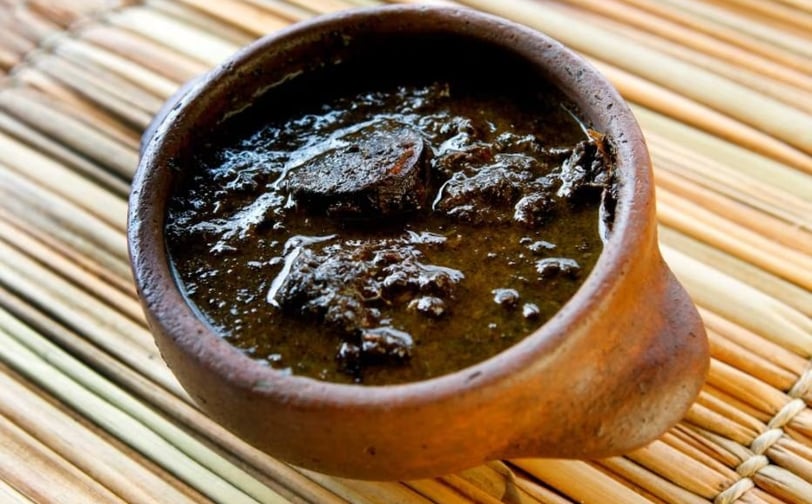Manicoba: An Amazonian Health Secret?
Explore maniçoba, a traditional Amazonian dish from Belém poised to be Brazil's next health hero. Don't let its appearance fool you!
HEALTHY DISHES
CILZA DUARTE
4/20/20255 min read


Maniçob will transform your health journey.
The first time I encountered maniçoba, I was certain I was looking at some strange, murky potion rather than dinner. The dark, almost intimidating appearance of this traditional Amazonian dish concealed what would become one of my most profound culinary revelations. (And trust me, I've had my fair share of food epiphanies.)
Have you ever wondered what would happen if the lush Amazon rainforest and sun-soaked Mediterranean shores somehow collided on your plate? That's the magic of maniçoba—Brazil's unsung health hero that deserves a permanent spot in the global superfood conversation.
When Two Worlds Collide: Amazon Meets Mediterranean
The health world can't stop obsessing over Mediterranean diets. Olive oil this, fresh fish that. The endless parade of Mediterranean-inspired cookbooks could fill an entire library.
But what if I told you that tucked away in northern Brazil's Pará region exists a dish that rivals—and in some nutritional categories, even surpasses—the celebrated Mediterranean diet?
Maniçoba, lovingly nicknamed "feijoada's cousin" by locals, begins with cassava leaves (maniva) that undergo a remarkable transformation. These leaves, naturally toxic in their raw state, are patiently boiled for nearly a week (yes, you read that correctly) until they become not just safe but sublimely nutritious.
This extensive cooking process isn't just about safety—it's a time-honored ritual that extracts maximum nutrition while developing flavors that cannot be rushed. This meticulous preparation mirrors the slow-food philosophies that Mediterranean cultures have practiced for centuries.
The Nutritional Powerhouse You've Never Heard Of
Let's put our nutrition detective hats on for a moment.
Mediterranean diets shine through their balance of omega-3s, fresh vegetables, and lean proteins. Maniçoba delivers this same trifecta through an entirely different ecosystem of ingredients.
The cassava leaves that form the foundation of this dish are nutritional dynamite:
Rich in iron that rivals spinach (a Mediterranean staple)
Packed with fiber that promotes digestive health
Loaded with protein that sustains energy levels throughout the day
Then comes the addition of various salted meats—ranging from bacon to jerked beef—contributing complete proteins and that satisfying savory element that makes both Mediterranean and Amazonian cuisine so addictive.
Na verdade, pensando melhor, the protein combination in maniçoba is particularly fascinating. While Mediterranean diets often rely on fish and occasionally lamb for protein, maniçoba's various cured meats provide similar protein profiles but with a distinct uptake pattern that some nutritionists believe leads to more sustained energy release.
"Tu já comeste maniçoba?" The Cultural Context
"Have you eaten maniçoba yet?" This common greeting in parts of Pará speaks to the dish's cultural significance. Much like how Mediterranean communities gather around shared meals of paella or moussaka, maniçoba brings people together.
It's traditionally the centerpiece of Círio de Nazaré, one of Brazil's largest religious festivals, where this labor-intensive dish symbolizes devotion and community spirit. This connection between food and celebration mirrors the Mediterranean approach to dining—where meals are never just about nutrition, but about nurturing relationships.
I once watched an elderly woman in Belém prepare maniçoba for her family, stirring the dark green mixture with the same reverence a Greek grandmother might show while tending to her moussaka. "Com licença," she said with a smile, gently shooing me away from hovering too close to her culinary masterpiece. The cultural pride was unmistakable.
The Science Behind the Superfood
What truly connects maniçoba to the Mediterranean diet isn't just cultural similarities—it's the underlying nutritional science.
Both dietary approaches feature:
Complex carbohydrates that provide sustained energy
A rich array of micronutrients often missing in modern diets
A balance of proteins and fats that promote satiety
The cassava plant itself is a marvel of efficiency, growing in soils where many other crops would fail. This environmental resilience translates to nutritional resilience—creating a food that nourishes deeply.
Mediterranean diets are celebrated for their heart-health benefits. Early research suggests that the unique combination of iron, fiber, and antioxidants in properly prepared cassava leaves may offer similar cardiovascular protection.
(Though I should note here that moderation is key—the traditional preparation does include salt-cured meats, which should be enjoyed mindfully.)
From Forest to Table: Sustainability Parallels
One aspect rarely discussed when comparing these two food traditions is their inherent sustainability.
Both the Mediterranean and Amazonian approaches to food emphasize:
Using local, seasonal ingredients
Employing preservation techniques to minimize waste
Creating dishes that utilize every part of the plant or animal
In an era of industrial food systems, there's something profoundly refreshing about traditions that have sustainability woven into their very fabric.
The cassava plant represents remarkable agricultural efficiency—thriving in challenging soils and requiring relatively little water compared to many staple crops. Its cultivation has supported Amazonian communities for centuries, much as olive groves have sustained Mediterranean villages.
"É de lamber os beiços!" The Flavor Experience
"It'll make you lick your lips!" This Amazonian expression perfectly captures what happens when you try maniçoba for the first time.
The flavor profile is nothing short of transformative:
A deep earthiness from the week-long simmered leaves
Rich umami notes from the varied meats
A subtle complexity that develops as you continue eating
This multidimensional flavor experience parallels the celebrated tastes of Mediterranean cuisine, where each bite reveals new notes and dimensions.
My first taste of proper maniçoba came alongside a small glass of tacacá (another Amazonian specialty). The combination was revelatory—showcasing how these regional flavors complement each other in the same harmonious way that Mediterranean meals progress from appetizers to main courses.
Bringing Maniçoba Into Your Modern Health Journey
Now, I understand that not everyone can dedicate a week to simmering cassava leaves. Fortunately, in Brazil, you can find pre-cooked maniva paste that dramatically shortens preparation time without compromising nutrition.
For those outside Brazil seeking to incorporate this Amazonian wisdom, consider these principles:
Embrace slow-cooking methods for leafy greens to extract maximum nutrition
Balance plant-based foundations with modest portions of quality proteins
Seek ingredients with natural preservation properties (like properly prepared cassava)
Honor the cultural context of your food choices
The Mediterranean diet wasn't built in a day, and neither was the traditional Amazonian approach to nutrition. Both evolved over generations of careful observation and cultural wisdom.
When Worlds Truly Collide: A Fusion Approach
Agora, thinking outside the traditional box for a moment, what happens when we actively merge these two nutritional powerhouses?
Imagine cassava leaf pesto drizzled over grilled fish. Picture tucupi (another cassava derivative) used as a deglazing liquid for a pan of Mediterranean vegetables. Consider jambu (an Amazonian herb with unique properties) sprinkled over a Greek salad.
These combinations aren't just culinary experiments—they represent the possibility of creating truly optimal nutritional approaches that transcend geographic boundaries.
My Amazon Food has pioneered several of these fusion approaches, creating accessible pathways for incorporating Amazonian wisdom into various dietary frameworks.
The Future of Global Nutrition Is in the Forest
What we're really talking about here isn't just a comparison between two regional diets. It's about recognizing that ancient food wisdom often contains solutions to modern health challenges.
The Mediterranean diet gained global recognition because researchers noticed something remarkable: people eating these traditional foods were living longer, healthier lives than those following modern Western diets.
Now, as we turn our attention to the Amazon, we're discovering similar patterns of wisdom—traditional foods that provide remarkable nutritional density while connecting people to their environment and each other.
Maniçoba isn't just a delicious curiosity—it's a window into a comprehensive approach to nutrition that deserves the same respect and scientific attention that Mediterranean traditions have received.
So next time someone raves about their Mediterranean diet plan, perhaps ask them: "But have you tried maniçoba?" You might just introduce them to their next health obsession.
After all, sometimes the most profound nutrition discoveries aren't found in laboratories or trendy urban restaurants—they're simmering slowly in traditional pots, tended by hands that have passed down wisdom through countless generations.
What forest foods will you explore next?
My Amazon Food is dedicated to bringing authentic Amazonian nutrition to health-conscious consumers worldwide. Discover our range of traditional and fusion products at www.myamazonfood.com
Inspiration - Health
Explore recipes, tips, and culinary articles today.
wellness
Flavor
cilzaduarte@gmail.com
55 81 98087-8684
© 2025. All rights reserved.
